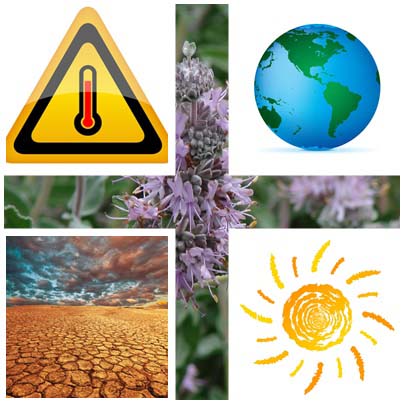Drought Praise: Around the World with Sunny Groundcovers

Bring on the sun. Bring on the heat. Bring on the drought-resistant Salvia groundcovers.
Flowers by the Sea has organized a short list of top choices to form an international team of drought fighters. They come from Asia, California, Mexico and Morocco in lavender, purple and pink to do battle against the boring brown caused by water shortage.
Similar to gravel, bark chip or pine needle mulch, these groundcovers discourage weeds, cool soil, conserve moisture and add color to gardens. They are living mulch.
Removing an Outdated Groundcover
Although turfgrass is the most familiar groundcover in America, it didn't become dominant until the late 1800s when lightweight manual lawnmowers became prevalent.
Previous to the 19th century, few common people in Europe or America had grass surrounding their homes. Lawns were a luxury of wealthy landowners, who could afford to surround part of their estates with landscaping instead of crops and kitchen gardens.
Unfortunately, most turfgrasses consume too much water to be practical when drought drags on or where climate is persistently dry. Consequently, many homeowners in the West are removing all or part of their lawns and replacing them with low water landscaping (xeriscape), including mulch and groundcovers.
Depending on local rainfall, water shortages and types of plantings, xeriscapes may receive regular but infrequent watering or no supplemental irrigation at all. The latter are often referred to as "dry gardens."
Tips for Successful Xeriscaping
Important suggestions to remember when xeriscaping, include:
Amending Soils. Mix fine grit or pea gravel into your soil if it is clay that doesn't allow plant roots to drain quickly.
Spacing. Space sages based on their size at maturity rather than jamming them together to speed up coverage. Crowding plants may increase future problems with disease, pests and pruning.
Using Mulch. Xeriscape minimizes or eliminates the need for mowing. Similarly, groundcovers decrease another expensive and time-consuming task -- the need to purchase and spread mulch annually. However, that doesn't mean that you can eliminate mulch altogether. Spread mulch around your plantings when they are becoming established, but don't cover the area near their stems where crown rot may occur from puddled water.
Selecting Best Mulch. Gravel is the best mulching material for drought-tolerant sages, because they need its mineral content and the better drainage it provides. Overly damp organic mulches may lead to mold.
Five Full-Sun Salvia Groundcovers for Drought
Here are five FBTS favorite groundcovers from around the world. All are deer resistant.
California
Bee's Bliss Sage (Salvia x 'Bee's Bliss') Zones 8 to 11
- Lavender flowers bloom winter to spring
- Fragrant, gray-green foliage is mat forming
- 24 inches tall and 96 inches wide in bloom
- Honeybees and hummingbirds
- Cross of S. leucophylla and S. sonomensis or S. clevelandii
Central Asia (Caucasus Mountains)
Caucasus Sage (Salvia canescens var. daghestanica) Zones 5 to 9
- Royal purple flowers bloom summer to fall
- Velvety silver-green foliage
- 12 inches tall and wide in bloom
- Butterflies
Mexico (Coahuila)
Coahuila Sage (Salvia coahuilensis) Zones 8 to 11
- Deep purple flowers bloom spring to fall
- Shiny green foliage with leaves smaller than S. greggii
- 24 inches tall and wide in bloom
- Butterflies, honeybees and hummingbirds
Mexico (Monterrey)
Royal Purple Autumn Sage (Salvia muelleri) Zones 7 to 9
- Royal purple flowers bloom spring to fall
- Fine, smooth green foliage
- 24 inches tall and 36 inches wide in bloom
- Cross of S. greggii and S. microphylla
- Heat tolerant
- Honeybees and hummingbirds
Morocco (Atlas Mountains)
Dandelion Leaf Sage (Salvia taraxacifolia) Zones 7 to 11
- Pale pink foliage blooms spring to summer
- Dandelion-cut, basal foliage with citrus fragrance
- 12 inches tall and wide in bloom
- Heat tolerant
Finding What You Need at FBTS
Want to view more of the groundcovers that we grow on our farm? A fast way to access that information is to click on the Salvias by Use category-- and then the Groundcover subcategory -- in the product menu of our online-only catalog. You'll find the menu at the top of our homepage.
Next, use our product filters -- which appear on category and subcategory pages -- to sort plants based on USDA zone, sun exposure and other cultural needs.
If you have more questions, don't hesitate to call or email us. We're glad to help and do our best to respond promptly.

 Salvia taraxacifolia
Salvia taraxacifolia  Salvia muelleri
Salvia muelleri  Salvia coahuilensis
Salvia coahuilensis  Salvia canescens var. daghestanica
Salvia canescens var. daghestanica  Salvia x 'Bee's Bliss'
Salvia x 'Bee's Bliss'
Comments
There are no comments yet.